I’ve always been bad with numbers.
Don’t get me wrong – my math ability has not yet failed my Asian stereotype. But there’s something about numbers that does not stick in my memory. As a result, history has never been my thing. As much as I would like to quote dates and statistics as if they’ve been printed with invisible ink on the back of my hand, I couldn’t even tell you the price of my favorite purse. As much as I love stories and random facts, this kept me out of history, at least for many years.
They say good teachers don’t just teach, they inspire. A great Social Studies teacher I had back in high school taught me how interesting history actually was. Listening to his lecture was like watching the latest TV show. Of course he didn’t act things out, but the drama was never missing, and the stories were true. Despite still not being able to tell you what year World War I start, he got me hooked on history. And history was one of the biggest reasons I fell in love with Italy in the first place.
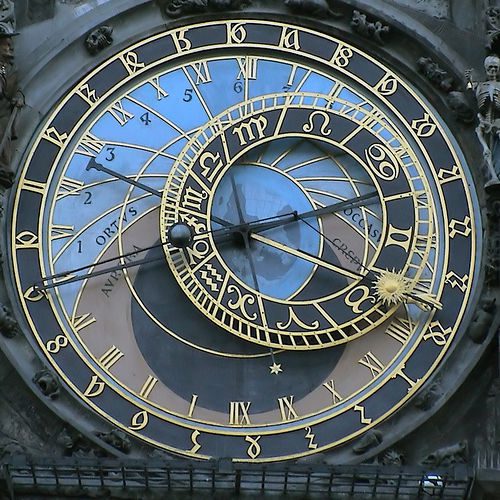
Our first stop as a tour group was Pompeii. It was sunny; the temperature was over 33 degree Celsius; and we were walking in streets built more than two thousand years ago. Few things can be more ‘Italian tourism’ to me. Our tour guide spoke slow but clear enough English, and my tour mates were just starting to remember each other’s names. I had made myself acquainted with a couple of people, but I was actually more interested in something I had never dreamed of being able to bear – the history of the abandoned walls.
With thousands, if not more, archeological sites across Italy, what makes Pompeii special is not how it started, but how it ended. According to Wikipedia, Pompeii was destroyed in year 79AD by an eruption of a close volcano, and was buried under dust until 1749, when it was rediscovered. The volcano destroyed all the lives in this ancient city, but left the city intact for over one and a half millennium. It’s as if the city has traveled through time, leaving its occupants behind, taking their stories to the future.

If I tell you exactly what I had learned that day, it would become a history lesson. But the fact is that being able to walk on the same ground people walked on two thousand years ago gives me a very deep feeling, as if I have somehow connected with these people who had no clue about my existence. I wonder hundreds of years from now, will there be another person thinking something like this about me?
It reminds me of some days ago, I answered a call from the Census office, asking some very general questions about me. At the end of the conversation, she asked whether it would be okay for people to use this information 97 years from now. I remember thinking: why 97 years? Why not simply “after you die”? Anyway, I said yes and a picture of me being a part of a big number on an old, yellowish page popped in my mind. I wonder how many people are able to remember that number.
Despite making me think about these existential questions, Pompeii was a decent tour. It really showed how smart we were and how we have not been evolving as fast as we think we are.
For example, like all ancient cities, Pompeii was centered on a sanctuary – in this case, the Apollo Altar. Visitors had to dip their fingers into the holy water and touch their foreheads with it before entering into the altar, as a way of purification. Does this ritual sound familiar?
Pompeii was also a very metropolitan city. Merchants from many places, speaking dozens of different languages, all came together in this multicultural capital. Stores, spas, even bars had been set up to entertain the visitors. Symbols were carved into the walls of stores in order to diminish the language barrier. Crosswalks and ‘parking’ places (i.e. where you can tie your horse or cow) were also set up along the sidewalks.
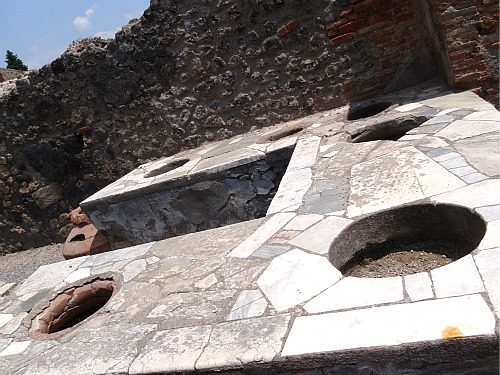
With all these history lessons I learned from the two-thousand-year-old streets, I guess there isn’t a moral of the day. As I sat with the evening breeze and my delicious dishes with unpronounceable names, I consider it a good day. The next morning we would leave these brown walls and head south. With stronger sunshine, higher temperature, and more history lessons to come, I couldn’t wait to hit the road.
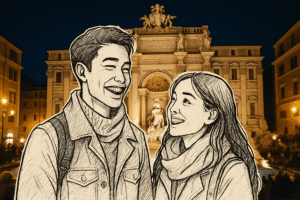
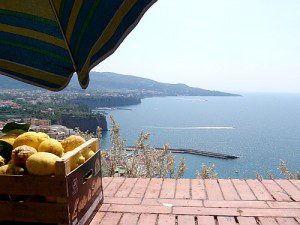
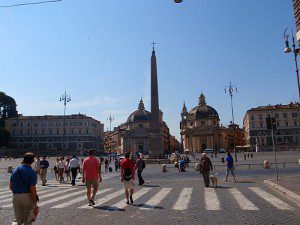
I’d love to visit Pompeii! so filled with history…and tragedy! [and I’m with you on hating math…and for the record, i didn’t fit the asian stereotype at ALL in the respect!]
History is wonderful when there’s no numbers involved :D, but on the other hand, numbers tell stories too. If Pompeii weren’t destroyed that many years ago, the tales wouldn’t be as elegant.
I’ve always been intrigued by Pompeii – how remarkable that it was so perfectly preserved. I enjoyed reading about the lessons you learned!
Glad to hear you enjoyed it, Andrea. Sadly some parts of Pompeii were affected in an earthquake several decades ago. I wish I could learn more about Pompeii too – if only the walls could talk.
Nice post Summer :). Same here about history. I remember loving the stories being scared out of my pants about memorizing dates in class. I’m definitely inspired to revisit the stories again though. Thanks for that!
It’s interesting how history can be more dramatic than fiction sometimes… but again history was what inspired writers in the first place.
*sigh* oh italy. verona is a great lltite city- it was the first i visited when i went to the country and what originally caused this love affair. enjoy a grappa (if you can, otherwise choke it down like i do)!
I visited Pompeii with my sister many years ago. I had no idea it was so enormous! I was expecting a couple rows of houses, not an entire city! Nice write-up 🙂
Glad you like it, Michael 🙂
It was surprising for me too, especially how well it was organized, with signs and all. Like the tour guide said, it was a really cosmopolitan capital. Guess we need to give more credit to these ancient people.
I loved exploring the ruins of Pompeii. I hope to return and see more of it. It really requires at least a couple of days.
Sounds like an ambitious project, Lisa. I think the more history you know, the better it is. Hope it turns out great for you 🙂
My daughter has a book about a street through time. 2000 years ago, that street looks much like today – with shops and cafes and people. The only real differences seems to be the clothes – and horses rather than cars. Then disaster strikes and everything falls apart. It’s back to the beginning and it takes 2000 years before the street has reached the same level of ‘civilization’ again. Fascinating! Makes you wonder what would happen if ….